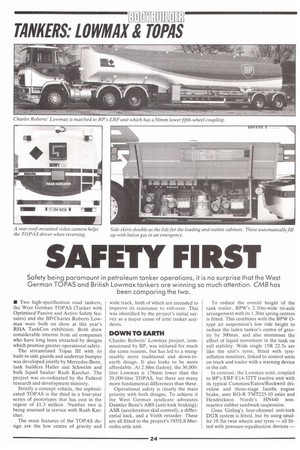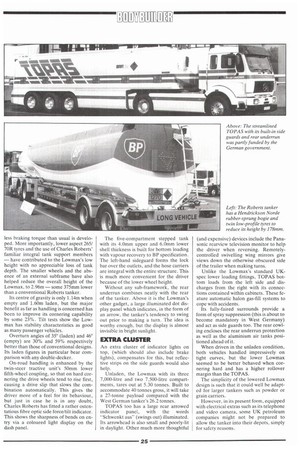SAFETY FIRST
Page 124

Page 125

If you've noticed an error in this article please click here to report it so we can fix it.
Safety being paramount in petroleum tanker operations, it is no surprise that the West German TOPAS and British Lowmax tankers ore winning so much attention. CMB has been comparing the two.
• Two high-specification road tankers, the West German TOPAS (Tanker with Optimised Passive and Active Safety features) and the BP/Charles Roberts Lowmax were both on show at this year's RHA TankCon exhibition. Both drew considerable interest from oil companies who have long been attracted by designs which promise greater operational safety.
The streamlined Topas III with its built-in side guards and underrun bumper was developed jointly by Mercedes-Benz, tank builders Haller and Schwelm and bulk liquid haulier Raab Karcher. The project was co-ordinated by the Federal research and development ministry.
Strictly a concept vehicle, the sophisticated TOPAS is the third in a four-year series of prototypes that has cost in the region of /1.3 million. Number two is being assessed in service with Raab Karcher.
The main features of the TOPAS design are the low centre of gravity and wide track, both of which are intended to improve its resistance to roll-over. This was identified by the project's initial survey as a major cause of artic tanker accidents.
DOWN TO EARTH
Charles Roberts' Lowmax project, commissioned by BP, was initiated for much the same reasons, but has led to a recognisably more traditional and down-toearth design. It also looks to be more affordable. At 2.88m (laden), the 36,000litre Lowmax is 178mm lower than the 39,000-litre TOPAS, but there are many more fundamental differences than these.
Operational safety is clearly the main priority with both designs. To achieve it the West German syndicate advocates Daimler Benz's ABS (anti-lock braking); ASR (acceleration skid control); a differential lock, and a Voith retarder. These are all fitted to the project's 1935LS Mercedes artic unit. To reduce the overall height of the tank trailer, BPW's 2.10m-wide tri-axle arrangement with its 1.30m spring centres is fitted. This combines with the BPW 0type air suspension's low ride height to reduce the laden tanker's centre of gravity by 300mm, and also minimises the effect of liquid movement in the tank on roll stability. Wide single 15R 22.5s are like the unit's tyres, fitted with tyreinflation monitors, linked to control units on truck and trailer with a warning device in the cab.
In contrast, the Lowmax semi, coupled to BP's ERF E14-32TT tractive unit with its typical Cummins/Eaton/Rockwell driveline and three-stage Jacobs engine brake, uses RO-R TM'T225-10 axles and Hendrickson Norde's HN440 nonreactive rubber sandwich suspension.
Grau Girling's four-channel anti-lock DGX system is fitted, but by using smaller 19.5in twin wheels and tyres — all fitted with pressure-equalisation devices — less braking torque than usual is developed. More importantly, lower aspect 265/ 70R tyres and the use of Charles Roberts' familiar integral tank support members — have contributed to the Lowmax's low height with no appreciable loss of tank depth. The smaller wheels and the absence of an external subframe have also helped reduce the overall height of the Lowmax, to 2.96m — some 375mm lower than a conventional Roberts tanker.
Its centre of gravity is only 1.14m when empty and 1.60m laden, but the major benefit as far as handling is concerned has been to improve its cornering capability by some 23%. Tilt tests show the Lowmax has stability characteristics as good as many passenger vehicles.
Overturn angles of 35° (laden) and 46° (empty) are 30% and 59% respectively better than those of conventional designs. Its laden figures in particular bear comparison with any double-decker.
On-road handling is enhanced by the twin-steer tractive unit's 50mm lower fifth-wheel coupling, so that on hard cornering the drive wheels tend to rise first, causing a drive slip that slows the combination automatically. This gives the driver more of a feel for its behaviour, but just in case he is in any doubt, Charles Roberts has fitted a rather ostentatious fibre optic side force/tilt indicator. This shows the sharpness of bends on entry via a coloured light display on the dash panel. The five-compartment stepped tank with its 4.0mm upper and 6.0mm lower shell thickness is built for bottom loading with vapour recovery to BP specification. The left-hand sideguard forms the lock bar over the outlets, and the hose carriers are integral with the entire structure. This is much more convenient for the driver because of the lower wheel height.
Without any sub-framework, the rear underrun combines neatly with the rear of the tanker. Above it is the Lowmax's other gadget, a large illuminated dot display panel which indicates, in the form of an arrow, the tanker's tendency to swing out prior to making a turn. The idea is worthy enough, but the display is almost invisible in bright sunlight.
EXTRA CLUSTER
An extra cluster of indicator lights on top, (which should also include brake lights), compensates for this, but reflective strips on the side guards would also help.
Unladen, the Lowmax with its three 7,000-litre and two 7,500-litre compartments, tares out at 5.30 tonnes. Built to accommodate 40 tonnes gross, it will take a 27-tonne payload compared with the West German tanker's 26.2 tonnes.
TOPAS too has a large rear arrowed indicator panel, with the words "Schwenkt aus" (swings out) illuminated. Its arrowhead is also small and poorly-lit in daylight. Other much more thoughtful (and expensive) devices include the Panasonic rearview television monitor to help the driver when reversing. Remotelycontrolled swivelling wing mirrors give views down the otherwise obscured side of the trailer when making turns.
Unlike the Lowmax's standard UKspec lower loading fittings, TOPAS bottom loads from the left side and discharges from the right with its connections contained within cabinets. These feature automatic halon gas-fill systems to cope with accidents.
Its fully-faired surrounds provide a form of spray suppression (this is about to become mandatory in West Germany) and act as side guards too. The rear cowling encloses the rear underrun protection as well as the aluminium air tanks positioned ahead of it.
When driven in the unladen condition, both vehicles handled impressively on tight curves, but the lower Lowmax seemed to be better behaved when cornering hard and has a higher rollover margin than the TOPAS.
The simplicity of the lowered Lowmax design is such that it could well be adapted for larger tankers such as powder or grain carriers.
However, in its present form, equipped with electrical extras such as its telephone and video camera, some UK petroleum companies might not be prepared to allow the tanker into their depots, simply for safety reasons.








































































































































